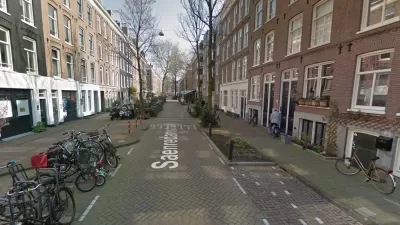While critiquing one of my blog posts, Prof. Randall Crane asked: "Is any parking regulation a net social burden or only 1.75 spaces per Jacksonville, Florida apartment?" This question in turn is an example of a broader question: how do we resolve an issue when we don’t know, and perhaps have no way of knowing, the ideal empirical answer? Parking regulation presents a classic example: looking at environmental harm alone, it seems to me clear that minimum parking requirements create some environmental harm by on balance encouraging driving, but also reduce environmental harm from "cruising" (motorists wasting time and fuel searching for parking spaces).*
While critiquing one of my blog posts, Prof. Randall Crane asked: "Is any parking regulation a net social burden or only 1.75 spaces per Jacksonville, Florida apartment?" This question in turn is an example of a broader question: how do we resolve an issue when we don't know, and perhaps have no way of knowing, the ideal empirical answer?
Parking regulation presents a classic example: looking at environmental harm alone, it seems to me clear that minimum parking requirements create some environmental harm by on balance encouraging driving, but also reduce environmental harm from "cruising" (motorists wasting time and fuel searching for parking spaces).*
But like Crane, I'm not sure if there's any way to quantify these consideration in a way that gives us the ideal number of parking spaces for a given use. So how do we break the tie where empirical data is scanty?
Generally, local governments seem to use traffic flow as the tie-breaking principle: when in doubt about the empirical consequences of a policy, choose the answer that helps the greatest number of vehicles move the greatest number of miles as speedily as possible. Having lived in places where government consistently follows this principle, I am not particularly satisfied with the results, because I believe the "traffic flow first" principle involves other important values. In particular:
*The tie goes to freedom. Where the factual results of policy alternatives are unclear, I tend to favor the solution that involves the least government regulation, because I believe that negative freedom- that is, freedom from government intrusion- is a useful value.
*The tie goes to (positive) freedom. Where the facts are unclear, I favor maximizing positive freedom, by which I mean increasing the level of transportation choice. Where walking and bicycling are so uncomfortable as to be impractical for sane people, consumer choices are limited. In less car-dependent environments, consumer choices are increased.
*The tie goes to equality. Where the facts are unclear, I favor the solution that aids those too young, disabled or needy to drive, as opposed to the solution that aids the rich and the middle class at the expense of the poor.
In many situations, these values are in conflict. For example, urban growth boundaries may increase positive freedom (by making city living a more practical choice) yet reduce negative freedom by increasing government regulation of land use. And their impact on equality is unclear: on the one hand, growth controls might increase real estate prices (bad) but where a region's poor live in cities and older suburbs, growth boundaries might, by saving such municipalities from being hollowed out, increase the tax base available for serving the poor (good) and increase the number of jobs within commuting distance of the urban poor (also good).
But parking presents none of these tough calls. By favoring drivers at the expense of (mostly poorer) nondrivers, minimum parking requirements are anti-equality and anti-positive freedom. By inconveniencing landowners, minimum parking requirements reduce negative freedom. Hence, where empirical knowledge is scarce, my inclination is to eliminate such regulations.
*See my blog post at http://www.planetizen.com/node/44907 for a more extensive discussion.

Alabama: Trump Terminates Settlements for Black Communities Harmed By Raw Sewage
Trump deemed the landmark civil rights agreement “illegal DEI and environmental justice policy.”

Study: Maui’s Plan to Convert Vacation Rentals to Long-Term Housing Could Cause Nearly $1 Billion Economic Loss
The plan would reduce visitor accommodation by 25% resulting in 1,900 jobs lost.

Planetizen Federal Action Tracker
A weekly monitor of how Trump’s orders and actions are impacting planners and planning in America.

Waymo Gets Permission to Map SF’s Market Street
If allowed to operate on the traffic-restricted street, Waymo’s autonomous taxis would have a leg up over ride-hailing competitors — and counter the city’s efforts to grow bike and pedestrian on the thoroughfare.

Parklet Symposium Highlights the Success of Shared Spaces
Parklets got a boost during the Covid-19 pandemic, when the concept was translated to outdoor dining programs that offered restaurants a lifeline during the shutdown.

Federal Homelessness Agency Places Entire Staff on Leave
The U.S. Interagency Council on Homelessness is the only federal agency dedicated to preventing and ending homelessness.
Urban Design for Planners 1: Software Tools
This six-course series explores essential urban design concepts using open source software and equips planners with the tools they need to participate fully in the urban design process.
Planning for Universal Design
Learn the tools for implementing Universal Design in planning regulations.
Caltrans
Smith Gee Studio
Institute for Housing and Urban Development Studies (IHS)
City of Grandview
Harvard GSD Executive Education
Toledo-Lucas County Plan Commissions
Salt Lake City
NYU Wagner Graduate School of Public Service





























